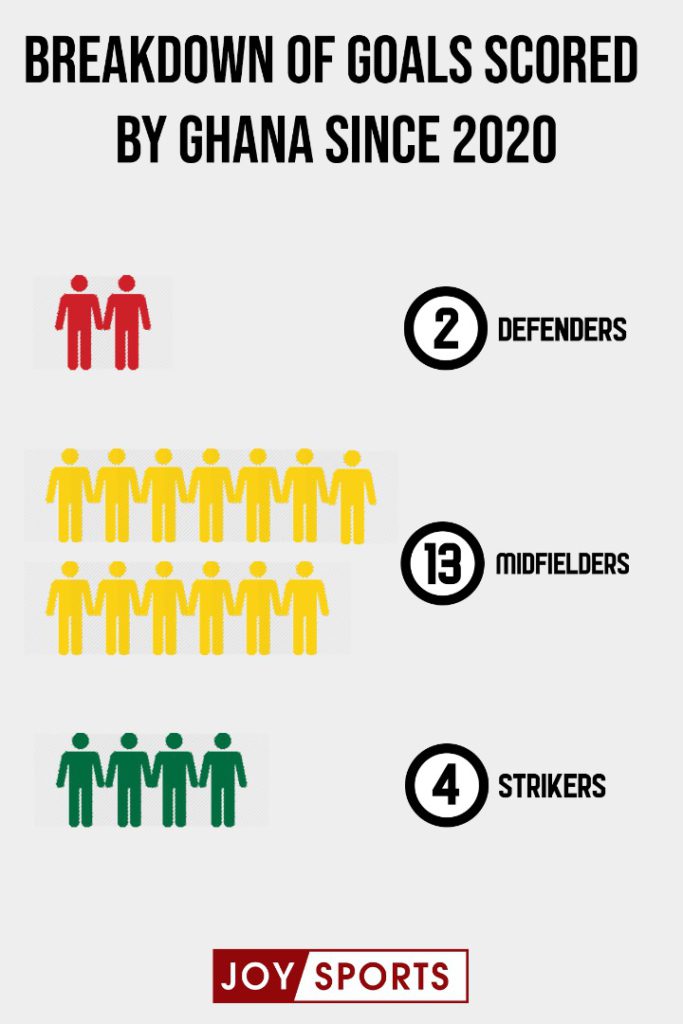The Black Stars are facing the tricky task of beating South Africa at the Cape Coast stadium, in order to progress to the play-offs of the FIFA World Cup qualifiers.
All Ghana needs to do is win the game by any margin to book a place in the next stage and keep their World Cup dreams alive.
The run of form of Ghana’s strikers, however, is threatening to maintain Ghana’s Qatar 2022 hopes as nothing but a dream.
The last time a striker scored for the Black Stars was Jordan Ayew’s penalty against Sao Tome and Principe in March. Since then, Ghana’s strikers have been on holiday – shored up and been unable to score in seven straight games in eight months.
Four midfielders; Wakaso, Partey, Kudus, and Andre Ayew have scored the majority of Ghana’s goals since a striker last scored for the Black Stars.
Since 2020, 8 strikers have made a combined 26 appearances for the Black Stars.
Of the eight strikers, Jordan Ayew has made the most appearances with Caleb Ekuban behind the Crystal Palace striker.
Ghana at the moment can’t seem to rely on strikers for goals, but how did a nation that blessed with so many attacking talents get here?
Lack of consistency
Out of the eight different strikers to have represented the Black Stars since October 2020, Jordan has made the most appearances.
He is followed closely by Caleb Ekuban with Andy Boakye-Yiadom the latest invitation to break the goal-scoring duck of Ghana’s strikers.
Jordan has evolved into the senior national team’s go-to striker, and as a result, has racked up more minutes than the other seven.
He has started 10 of Ghana’s 13 games in the period. Ekuban has started two games – one with Jordan, while Fameyeh has also recorded two starts in the period. The combined number of starts (7) of the other strikers is three short of Jordan’s 10.

All others have been limited to only one start, cementing regular places on the bench. Out of all the strikers who have made cameos off the bench, only Ekuban has managed to get on the score sheet, and that was more than a year ago.
In 1,573 combined minutes, Ghana’s strikers have managed only two goals since 2020.
Jordan Ayew – Ghana’s main man
The Crystal Palace striker made his Black Stars debut on September 5, against Swaziland in the 2012 AFCON qualifiers. He scored his first and second Black Stars goals four years later against Lesotho in Kumasi.
His first and only hat-trick for the team came in a prep game versus South Korea in a 4-0 victory. Since Asamoah Gyan’s last appearance for the Black Stars, Jordan Ayew has been Ghana’s main centre-forward and has made 68 appearances for the senior national team.
He’s scored 18 goals in those 68 appearances, with his last goal coming eight months ago. Quite clearly, Jordan is not the most prolific but his use by the national team has not helped him either.
Jordan has mostly operated as a sole striker for the Black Stars since 2020. In a 4-2-3-1 which has been the main system used by the Black Stars, Jordan has been required to lead the line.
However Jordan’s profile does not fit the role. He likes having the ball to feet meaning, is less likely to play off the shoulders of defenders, occupy them or stretch opposition defence.
Even though he has always been deployed as number 9, he operates as a number 10 always coming short, occupying midfield or deeper positions and rarely plays as a traditional number 9.
Conclusion
In recent times, Milovan Rajevac has trusted Benjamin Tetteh and Boakye Yiadom to lead the line.
Both players failed to bury any of the chances presented to them making the situation even more difficult for the Serbian coach.
With a lack of trust and depth, Rajevac could turn to one of his more prolific midfielders to deputise in a more advanced role.
In the Black Stars’ away game to South Africa, Andre Ayew was deployed as a striker. But that experiment failed woefully, with Ghana putting up a spineless performance.
All other midfielders who have recently been called up to the national team; Kudus, Partey, Fosu, Issahaku and Sulemana also don’t seem to have the skill set to play as false 9s.
In this situation then, a system with two strikers can be trialed, probably a 4-4-2. The downside however is a midfielder will be sacrificed to accommodate the extra striker.
The long-term solution will be to invest into youth football to cutdown on the rate at which the national team outsources talent.
A case in study will be U-20 star, Fatawu Issahaku who has now carved for himself, a path into the national team.
